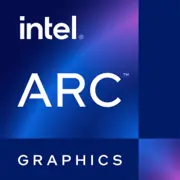Intel Arc A380M

Intel Arc A380M: Budget GPU for Beginner Gamers and More
April 2025
Introduction
The Intel Arc A380M graphics card, introduced in 2022, marked the company's initial foray into discrete graphics for laptops and compact PCs. By 2025, it remains relevant thanks to driver updates and optimizations. In this article, we'll explore who this model is suitable for, how it performs in modern tasks, and what to pay attention to when making a purchase.
1. Architecture and Key Features
Xe-HPG Architecture
The A380M is built on the Xe-HPG (High-Performance Gaming) architecture, specifically designed for gaming and multimedia tasks. The chip is manufactured using TSMC's 6nm process, which ensures a balance between energy efficiency and performance.
Unique Features
- XeSS (Xe Super Sampling): Upscaling technology similar to NVIDIA's DLSS and AMD's FSR. It helps increase FPS in games that support this feature while maintaining image detail.
- Hardware Ray Tracing: Built-in RT cores handle realistic lighting and shadows, but due to the limited number (8 cores), performance in ray tracing modes is modest.
- Deep Link: Optimizes collaboration with Intel's integrated graphics to accelerate rendering and streaming.
2. Memory: Speed and Capacity
GDDR6 and Bandwidth
The graphics card is equipped with 6GB of GDDR6 memory with a 96-bit bus. The bandwidth reaches 186GB/s, which is lower than competitors with 128-bit buses (e.g., NVIDIA GTX 1650 – 192GB/s).
Impact on Performance
For 1080p gaming, this amount is sufficient, but some projects with high texture settings (e.g., Cyberpunk 2077) may experience stutters. In professional tasks, 6GB limits work with heavy 3D scenes or neural network models.
3. Gaming Performance
1080p: Comfortable Gaming
- Fortnite (high settings, no RT): 65–75 FPS.
- Apex Legends (medium settings): 70–80 FPS.
- CS2 (maximum settings): 120–140 FPS.
1440p and 4K: Not for Everyone
At 1440p, FPS drops by 30–40%. For instance, Red Dead Redemption 2 yields 35–45 FPS on medium settings. For 4K, the card is not recommended—even in lighter projects (Overwatch 2), the frame rate rarely exceeds 50 FPS.
Ray Tracing
When RT is activated in Minecraft, FPS drops to 25–30 frames, but with XeSS enabled, it rises to 40–45. For smooth gaming with RT, a more powerful GPU is advisable.
4. Professional Tasks
Video Editing and Rendering
Thanks to support for AV1 and HEVC codecs, the A380M is effective for 4K video editing. In DaVinci Resolve, rendering a 10-minute video takes 12–15 minutes (compared to 8–10 minutes for the RTX 3050).
3D Modeling
In Blender using OpenCL, the card shows modest results: rendering the BMW scene takes 14 minutes (the RTX 3060 handles it in 7 minutes).
Scientific Calculations
For tasks on OpenCL (e.g., simulations in GROMACS), the A380M lags behind even budget NVIDIA cards due to a less developed driver ecosystem.
5. Power Consumption and Heat Generation
TDP and Recommendations
The TDP of the graphics card is 75W, allowing it to run without additional power supply. For a build with the A380M, suitable components include:
- A case with at least 2 fans (e.g., DeepCool MATREXX 40).
- CPU cooler: tower type (Cooler Master Hyper 212) or standard BOX.
Temperature Conditions
Under load, the GPU heats up to 70–75°C. In compact cases, overheating is possible—monitor ventilation closely!
6. Comparison with Competitors
NVIDIA GeForce GTX 1650
- Pros of NVIDIA: Better driver optimization, DLSS.
- Cons: No RT support, more expensive (around $160 compared to $130 for the A380M).
AMD Radeon RX 6400
- Pros of AMD: Higher performance in Vulkan games.
- Cons: Lack of hardware AV1 encoding support.
Conclusion: The A380M wins in price and support for modern codecs but falls short in gaming optimization.
7. Practical Tips
Power Supply
A 400–450W PSU is sufficient (e.g., be quiet! System Power 10). Ensure the PSU has an 80+ Bronze certification.
Compatibility
- Motherboard: PCIe 4.0 x8 (backward compatibility with PCIe 3.0).
- Processor: Intel Core i3/i5 10th generation or newer is recommended to avoid bottlenecks.
Drivers
Regularly update software through Intel Driver & Support Assistant. For older games (released before 2020), issues may arise—check for patches on the Intel website.
8. Pros and Cons
Pros:
- Low price ($130–$150).
- Support for AV1 and hardware Ray Tracing.
- Energy efficiency.
Cons:
- Weak drivers for older games.
- Limited memory capacity.
- Modest performance in 4K and RT modes.
9. Final Verdict: Who is the A380M for?
This graphics card is an ideal choice for:
- Budget gamers playing in 1080p at medium settings.
- Content creators working with AV1 encoding.
- Compact PC owners who value silence and low power consumption.
If you are not ready to spend more than $200 and do not demand maximum performance from games, the Intel Arc A380M will be a reliable companion. However, for professional 3D rendering or 4K gaming, it is advisable to consider more powerful solutions.
Prices are current as of April 2025. Check for promotions and updated models before purchasing!
Basic
Memory Specifications
Theoretical Performance
Miscellaneous
Benchmarks
Compared to Other GPU
Share in social media
Or Link To Us
<a href="https://cputronic.com/gpu/intel-arc-a380m" target="_blank">Intel Arc A380M</a>